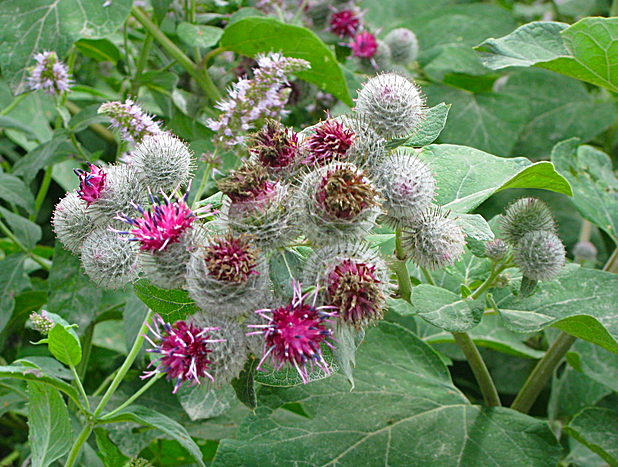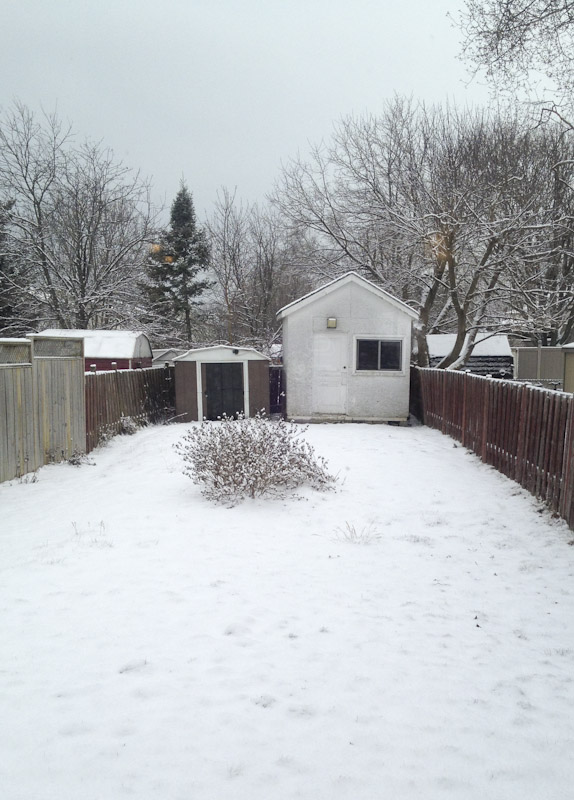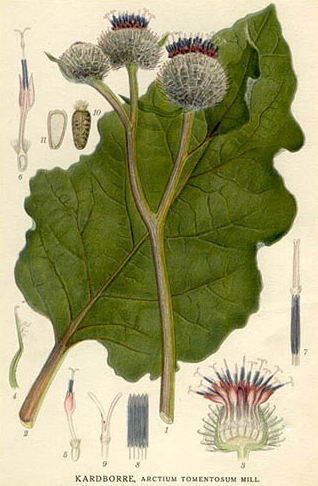Dealing with Burdock in Our Garden.

When we have moved to our new house, we have found our garden to be quite neglected. The only plants, which were growing here, beside grass and already spent daylilies, were weeds. One of the common weeds in this area, burdock plant, has grown very huge. Actually there were many burdock plants growing very abundantly beside an old tree trunk in the center of our garden.
In one of the pictures in this post, you can see it as this huge, already dry burdock plant growing right in the middle of our garden in January 2015, just after we have moved here. Even if in this picture it looks dry, its roots were very much alive and it already consisted of several mature plants. In the spring I have removed all visible burdocks being careful not to spread the seeds. Unfortunately it was already too late, since obviously this persistent weed had already spread its seed wildly not only around itself, but also in some other parts of my garden.

I am trying to get rid of burdock from my garden to this day. This plant is very hard to eradicate since the roots are very strong and deep (can grow up to about 1 foot – 30 cm). Even when a small part of the roots remains, the plants grows back and they are very hard to remove from my heavy clay soil, because they break easily.
I keep digging out the roots as much as I can and cutting the leaves not allowing the plants to bloom. I hope maybe they will just die back. I read this is a biennial plant and after it flowers in the second year it dies back. However I am not sure what would happen to the plants which are not allowed to bloom. I will find out this year since it would be at least the 3rd season of this burdock plants in my garden.
There is more than one variety of burdock growing as common weeds in my region and one of them is Arctium minus, commonly known as lesser burdock and the second kind is Arctium lappa, also called greater burdock. I think we probably have the first variety since it was not bigger than about 1,5 meter (5 feet) and the other variety could be even 3 m (10 feet) high.
General Information About Using Burdock as Food or Medicine.

First of all, I must mention, I am not a doctor and this is not a medical advice and just information I have found in my research. When treating any health problems using herbs, always ask a doctor who specializes in this field.
At least some varieties of burdock are edible and could be used for medicinal purposes. Greater burdock, besides being used as medicinal plant (particularly its roots), is also used as vegetables in some areas, especially in China, Japan and Korea. In Chinese burdock’s root is called niúbàng, in Japanese is gobō, in Korean ueong and it is very popular as food in these regions.
It also used to be commonly eaten in the Middle Ages in Europe, but now is is seldom eaten by European except in Italy and Portugal. This plant is also used as a vegetable in Brazil, New Zealand and Hawaii.
In Canada, because of the love of Chinese people for this plant as a vegetable, it could be sometimes found in Chinese stores. For example I have seen burdock roots sold in some stores in China Town in Toronto.
Lesser burdock (Arctium minus) is more commonly found growing in the wild in my area its roots can be also eaten and used in a similar way as Greater burdock’s.
Burdock’s Medicinal Properties and Use.
Burdock was also often traditionally used with dandelion in the form of soft drink or as medicine and it was, and still is, considered particularly valuable as a very strong body cleanser and blood detoxifying herbs. It is believed that it stimulates the release of waste products from the cells. As such is highly valued by Chinese, as well as Western traditional herbal medicine. It is said that it works so great with dandelions because of dandelion’s diuretic action on the body, which helps to release the toxins via kidneys and liver.
Burdock is considered as a herb which helps in restoring the balance of fluids in the body and strongly supports the immune system. Because of its detoxifying and immune stimulating properties, some people even use it as supporting herb when healing from cancer.
It is especially effective for some skin problems (occasionally also combined with clover), helping to heal the skin from scaliness (like in eczema and psoriasis), acne or other skin eruptions.
It also helps to break extra uric acid in the joints, helping with gout, arthritis and some other related health conditions.
Because of its bitterness, it also aids digestion and promotes appetite.
Even burdock leaves have some medicinal value and could be made into poultice (leaf is steamed first to soften). It is supposed to help with bruises, boils, acne, rheumatism, arthritis and similar problems and to accelerate the healing process.
The roots of this plants are best collected either in the first fall or in the second spring, because at this time their power is the strongest and the most concentrated there. As I have mentioned, the roots can be quite hard to dig up since they could be up to one foot long.
It really sounds like it is a very powerful and versatile plant good to be considered to be eaten as a healthy vegetable or for helping with some health challenges.
Do I Plan to Dig Up My Burdock for Food or Medicinal Purposes?
For now, I don’t plant to do it, since as I have mentioned, I am not allowing my burdock plants to grow big and the roots are rather thin and break easily. I don’t think the center of my garden is the best place to grow it. Also because burdock can easily become invasive, I would rather not grow it in my pretty small garden.
If I would like to use it as a vegetable or body tonic, I would rather buy it either as a vegetable, or dry plant from a reputable source, like for example from the Mountain Rose Herbs here. I am not in affiliation with them in any way, but I have noticed, that many people recommend them.
What kind of so called “weeds” do you have in your garden and do you use any of them as food or medicine? I look forward to your comments. Also if you like this article, please share it with your friends. Thank you.
Read the First Part of this Article.
To see the first pat of this article, please follow this link.
Copyright Info.
This article is copyrighted by me, Renata Ratajczyk. The photographs used in this article are either copyrighted by me or as otherwise mentioned.
Please contact me if you would like to use this article or any of my photographs. Thank you.
Related Articles.
How to Choose the Right Kind of Tomatos for Your Garden – Part 1.
Seven Important Questions to Ask When Choosing Plants for Your Garden.
How I Have Started My First Garden – Part 1: Deciding Where to Grow Flowers, Vegetables and Herbs.
